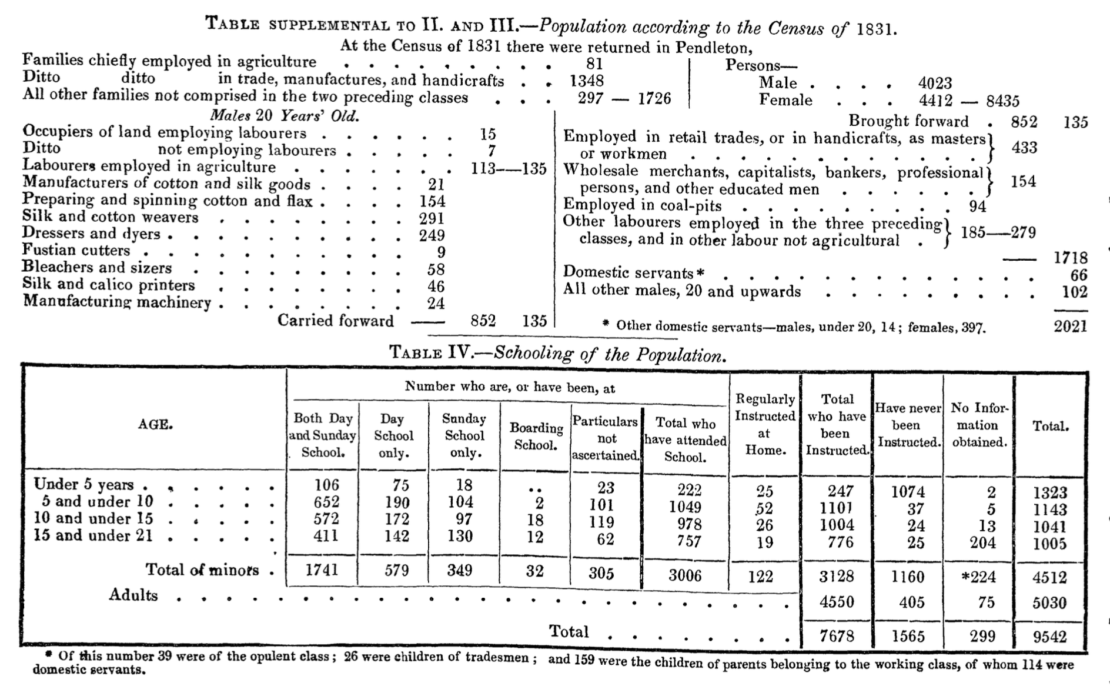The Township of Pendleton
Pendleton Township in the second half of the Eighteenth century taken from Harrop’s Manchester Mercury and General Advertiser with additional material from early nineteenth century censuses.
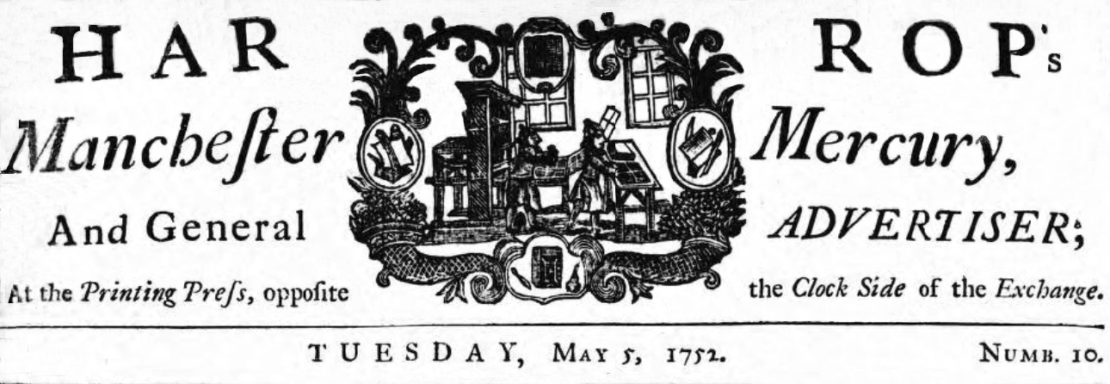
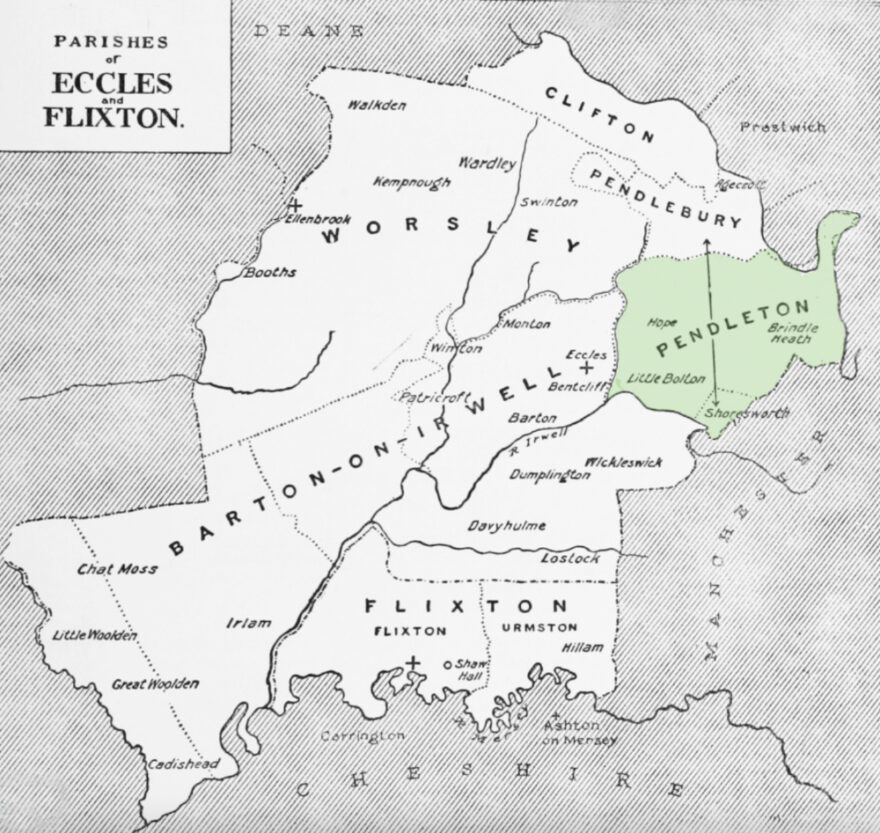

The township of Pendleton (in green above) was one of five townships in the parish of Eccles within the Salford Hundred. The Eccles townships also included Pendlebury, Clifton, Barton and Worsley. Adjacent Salford and Broughton townships were in the parish of Manchester. Information about the Pendleton township is piecemeal up to the second half of the eighteenth century but the advent of local newspapers and in particular the Manchester Mercury, published from 1752, gives brief but informative snapshots of Pendleton from this time. Amongst the newspaper reports, advertisements are particularly useful giving descriptions of house sales, the types of dwellings on offer, the associated land and outbuildings and the names of the owners, leaseholders and those managing the sales and lettings.
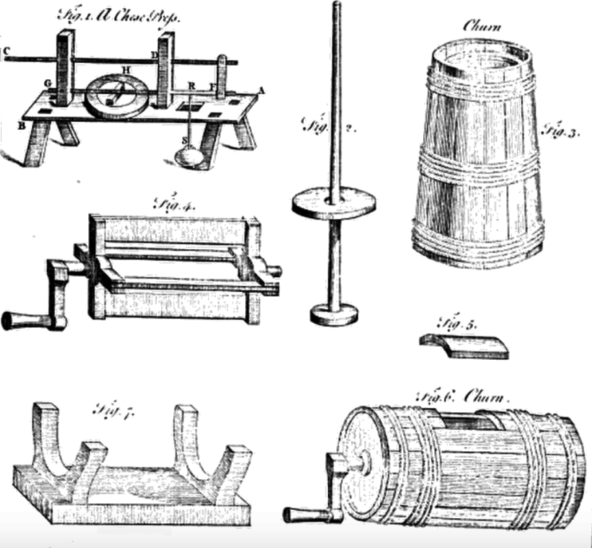
An early sale notice from 4 September 1753 gives details of a substantial property in Pendleton including a messuage or dwelling house with outbuildings and 20 acres of land. The sale has been occasioned by the death of John Whittle who has been renting the land from Richard Fitzgerald at £19 per annum. Those interested in taking on the remaining years of the lease are advised to enquire of Dauntesey Smith, attorney at law in Manchester.
John Whittle’s last will and testament is challenged by his son Hugh and is only ratified in February 1755 after a full inventory of his estate is undertaken and accepted at Chester. The inventory gives an interesting insight into the items required by a local yeoman farmer in his day to day activities. At the time of his death Whittle appears to have been a dairy farmer with five cows, two mares, a gelding, a cart, two butteries equipped with the requisite equipment and the usual household furniture and linen. It is difficult to locate this farm at the moment as Fitzgerald land was extensive and covered much of the township.
The Fitzgeralds had a long association with the township which lasted from 1733 to 1912. A 1763 warning from Fitzgerald’s gamekeeper, which is regularly repeated in the newspapers over the years, warns that ‘any unqualified person who shall fish, fowl, hunt or course upon the manors or lands of Richard Fitzgerald esq, lying within Pendleton in the Parish of Eccles in the County of Lancaster will be prosecuted as the law directs’. How the Fitzgeralds of Waterford came to acquire the Pendleton Estate is an interesting and eventful story. More of that later.

Richard Fitzgerald’s name crops up again in 1762 when a messuage and tenement from the Fitzgerald estate is offered for sale with a 31 year lease of which 18 years are remaining. At an annual rent of £9 the letting is at Irlams o th Height, the northernmost point of the Pendleton township. Richard Irlam, born in 1732, is organising the sale on behalf of his mother, the widow of Peter Irlam. Generations of the Irlam family are associated with Irlams o th Height, their births, marriages and deaths recorded in the Eccles parish records.
In February 1757 Samuel and Joseph Worsley (who died in 1788) decided to let the Little Bolton Hall estate which included a house and outbuilding with 31 acres. In 1786 Mrs Worsley, a widow, is selling timber from the same estate. Other timber sales are recorded in Pendleton including one in 1758 when a large quantity of fine ash timber and ‘big boilers ready felled and fit for planks for coopers use are on offer at New Hall Fold, near Pendleton Poll within one mile of Manchester’. Additionally, 38 oak trees, ‘now standing and numbered’ are also available from Henry Leyland. Timber sales advertised in the newspapers increased as the century progressed. To what extent the area was wooded requires some further research but it is clear that increased building, and in particular mills and factories and associated machinery would have required large amounts of timber as would everyday items associated with farming and bleaching.
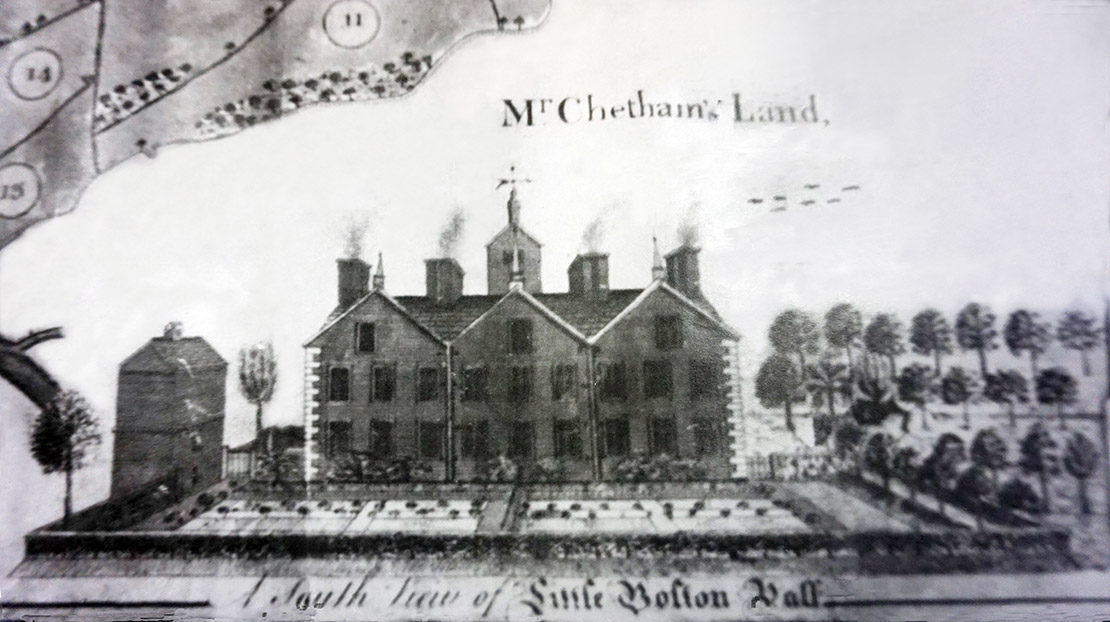
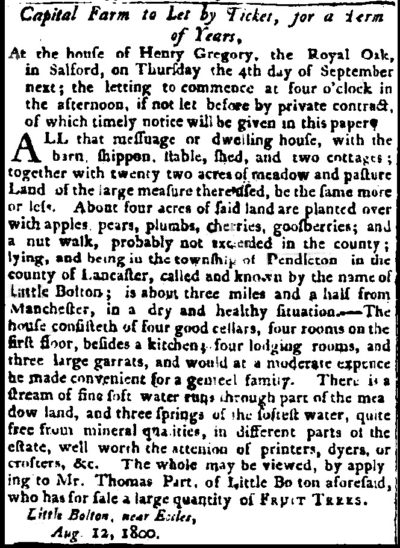
Many of the sales advertised in the newspapers take place at the King’s Head on Chapel Street, Salford where in 1762 John Robinson, the victualler, is hosting the auction of several lots including four acres of land known as Pellton Fields near to Sandy Lane. Additional details tell us that this land belonging to Richard Fitzgerald is adjoining the public road leading from Pendleton Pole to Warrington on one side and the public road from Pendleton Pole to Bolton on the other. We can surmise from the description that the fields are in the vicinity of the future Wool Pack Inn which probably dates from around 1766. The asking price per acre is 20 shillings before taxes. On the same day meadow and pasture land known as ‘Chapel Lands on Cross Lane and currently under lease to Trinity Chapel’ in Salford, is also auctioned. Several names appear on this and other adverts throughout the period: John Aldred and John Gregory both of Pendleton, James Seddon of New Barn and John Cooke, attorney at law in Salford are frequently mentioned individuals.
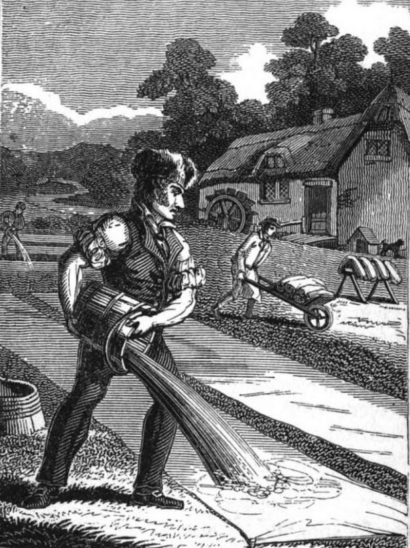
One year later in 1763 John Seddon, resident at Ackers Barn (possibly an alternative name for Acres Barn and probably in the vicinity of the later Acresfield House) is offering a handsome reward for information about a missing bay colt from his land. Not too far from Ackers Barn in the Weaste area a tenement called Foster Wood is also for sale, including a messuage and bleaching croft of ten acres , ‘well watered’ and ‘well furnished with conveniences for the bleaching business’ in the possession of John Gee. The south facing and sloping aspect of Weaste, overlooking the Cheshire plain and taking advantage of the pure atmosphere and stretches of water, makes this an ideal site for bleaching before the invention of chlorine in 1786. Local field names such as ‘tenter field’ and ‘drying field’ signify the early textile finishing industry in the area. The images to the left and below show the exposed bleaching fields and the requirement for locally available stretches of unpolluted water.
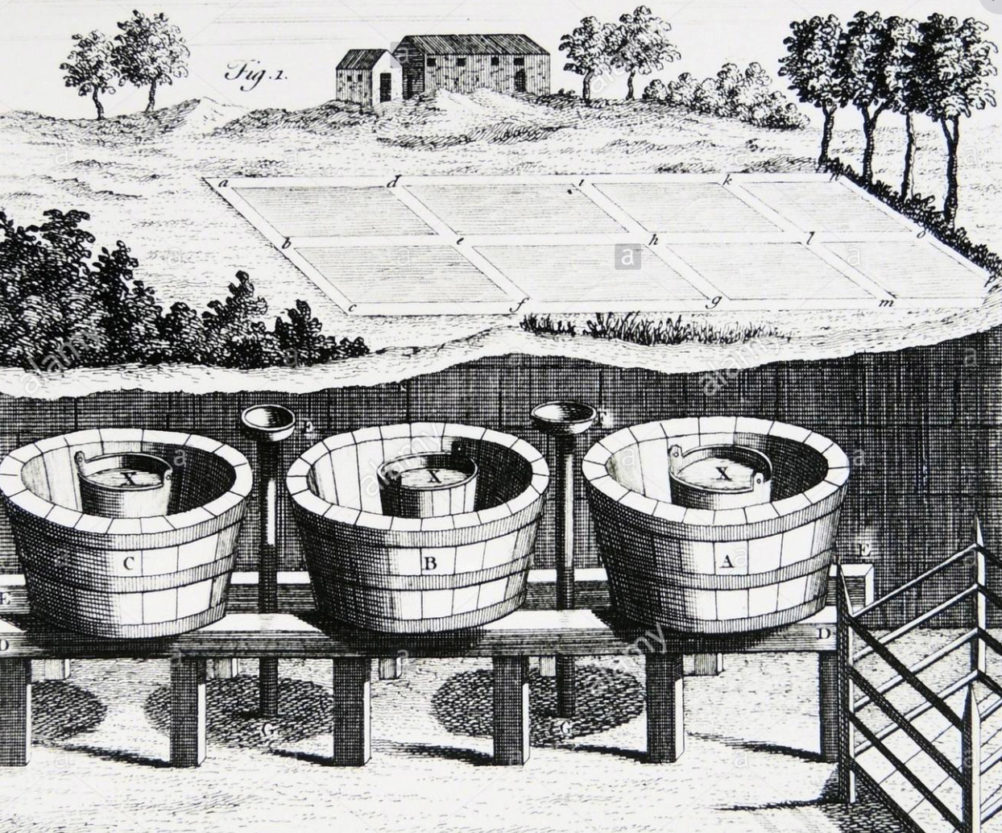
Sandy Lane features once again in an advert of 1763 when ‘the Sandy Lane tenement’, a house with outbuildings and a garden is to be let the following year. William Johnson is the current occupier. In the same advert a house with a barn and 12 acres in the occupation of Joshua Barratt is offered for rent as is ‘a brick house’ occupied by Mrs Bury, a widow, and her under-tenant. Interested parties are instructed to send their applications to Edward Woodward in Lincolns Inn, London, Richard Fitzgerald’s place of business.
These early newspaper adverts characterise Pendleton as a semi-rural environment with wildlife, woodland, pasture, orchards and barns interspersed with tenements, messuages and outbuildings. However, early textile processing is also evident in the Township. In 1764, 12 acres of meadow and pasture in the heart of Pendleton at the Pendleton Pole, near to the future site of St Thomas church, is to be let by John Gregory with six acres already in use as a fustian bleaching croft. Bleaching of cloth in the landscape was a time-consuming and also a seasonal activity, so bleachers would have combined this with agriculture, animal husbandry and artisan manufacture. Clean air, a prerequisite for bleaching and drying in the open air, suggests an environment lacking in pollution. But the open aspect of bleaching fields meant that they were often subject to theft. In 1766, at John Gregory’s bleaching croft at Pendleton, several items were stolen including a ‘counterpain, five yards of linnen cloth….four bed quilts….. half whited, and one sheet’. If apprehended and charged the felons would be subject to trial at the Quarter sessions. One report records yarn stolen from the Pendleton bleaching croft of Ann Hamer. The accused, John and Rachel Lee, were found not guilty of the crime and discharged, but the same newspaper report records that others stealing textiles were less fortunate, suffering transportation for seven years. Such was the fate of William Fitchew who was found guilty in April 1782 of stealing goods from John Birch’s croft at Pendleton. Birch was subject to further thefts in early 1783 when 20 yards of half ell cotton were stolen from his bleaching ground.
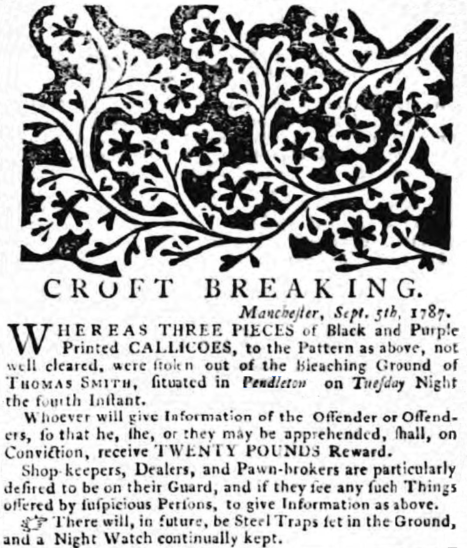
Thefts from bleaching fields continued to be reported for several decades and give some interesting contemporary descriptions about the textiles of the period. In 1778 Richard Withington’s bleaching ground in Pendleton was the site for a series of thefts including ‘one piece of half yard of lining jean nearly grey’, later found in a hedge near the turnpike gate. A few days later Withington was relieved of a grey garment piece 13 yards in length along with printed cotton handkerchiefs described as ‘light ground with India pattern the whites not clear, being just laid on the grass’. This early reference to what is either a woodblock or plate printed textile is interesting within the context of printed calico manufacture in Lancashire as is the description of the ‘exotic’ design.
In December 1782 Catherine Gregory of Pendleton suffered the theft of five yards of half-ell jean from her croft whilst John Gregory also lost twenty yards of ell wide cotton in early January 1783. This and other reports of theft mention an organization, The Committee for Prosecuting Felons,which operated from public houses in Bolton and Manchester. Meanwhile in 1765 at Hope Hall Thomas Butterworth Bayley had also experienced thefts from his gardens and orchards and resorted to placing a warning in the Manchester Mercury. The notice offered a five guinea reward for information about the felons but also warned that several steel traps had been set on his land to apprehend the perpetrators. Notice of traps was a requirement of the law during this period but at a time when many could neither read nor write one wonders about the efficacy of this notice. There is no further evidence of the traps’ success in apprehending the vegetable thieves! It wasn’t until 1827 that the law was changed regarding man traps and more humane versions were introduced! They were finally abolished in 1861.
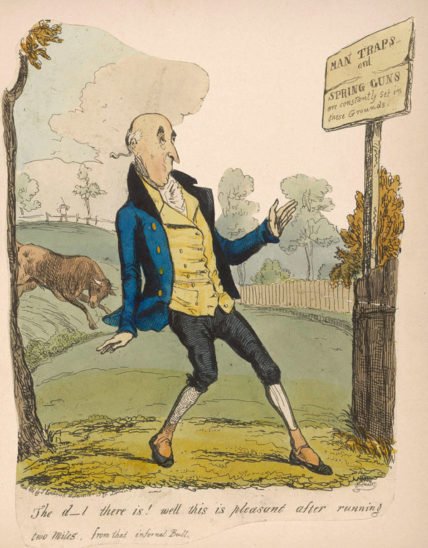
Bayley, a Manchester Justice of the Peace and local gentry, flexed his authoritarian muscles once more when he extracted a full public apology in the Manchester Mercury from David Griffith, a cart driver, in response to a collision on the turnpike road at Pendleton Pole at which Bayley is also subjected to insulting behaviour from Griffith. The apology, published in the newspapers in 1769, is long and groveling, and no doubt comes at considerable financial cost to Griffiths who signs the statement with his mark. A similar public apology appears in 1770 when John Coupe admits willfully driving his cart into Mr. Bayley’s carriage, then occupied by his wife and a female friend. Coupe is grateful for the leniency shown but no doubt Bayley’s association with the New Bailey prison and his position as a JP influences Coupe’s cringing public apology.
In 1766 the Manchester Mercury includes an intriguing extract from the will of Thomas Holland of Whit Lane in Pendleton which adds flavour to the Pendleton narrative. Holland leaves a curious legacy to his wife Alice in the form of a dog bite remedy to be made up and administered by Mrs Holland at their house in Whit Lane ‘for her sole benefit’. On her remarriage to Mr Ward, a surgeon and druggist in Stockport, Alice Holland continues to administer this potion from her second husband’s shop with the newspapers reporting on its effectiveness as an antidote. By 1771 the remedy is known as Ward’s Ormskirk Antidote and is sold nationwide.
Also around the year 1766 a familiar local landmark building appeared which was to become a focal point at Pendleton for over 200 years. The Woolpack was ideally located at the confluence of two major turnpike roads and as well as toll houses, a hostelry and brew house it was also the location for auctions, public meetings and the later bowling greens and the famous horse troughs. In 1774, ‘The house of Anthony Ingham at the sign of the Wool Pack’, was the location for the sale to the highest bidder of the great and small tithes ‘lying within the township of Pendleton’. One year later, a collier who had been to collect some gunpowder on behalf of the Duke of Bridgewater called at a ‘public house at the Pendleton Pole’. The collier’s friends decided on a prank which included coals from the fire resulting in a large explosion which blew out the windows, killed two and left a third ‘terribly scorched’. Anthony Ingham died in 1776 and was interred at the Collegiate Church in Manchester.
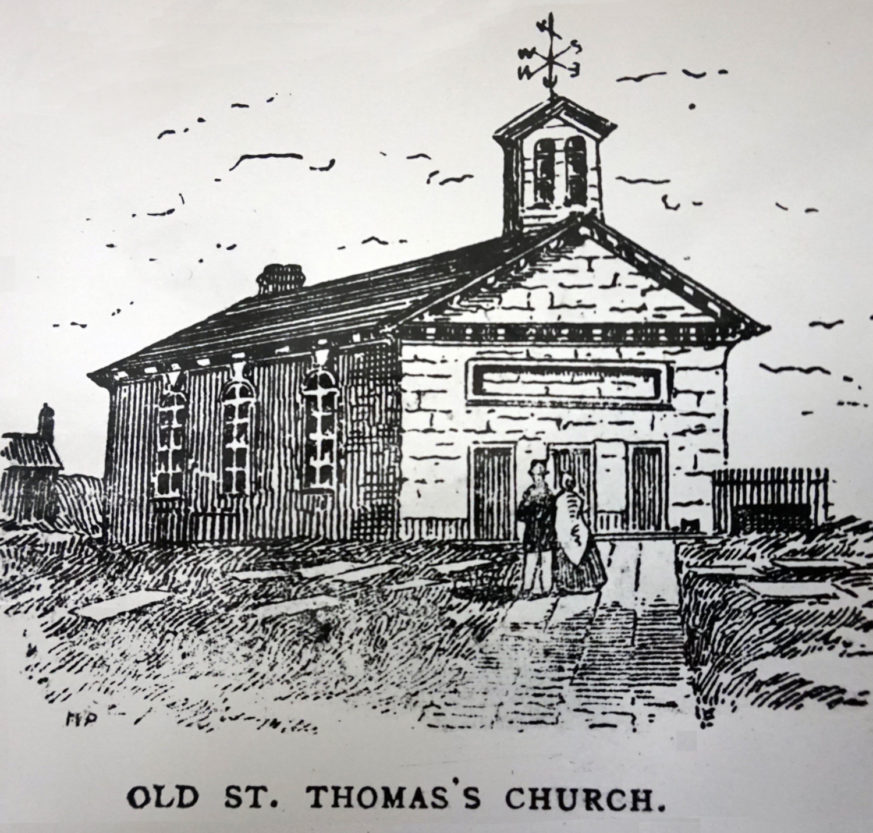
In 1774 land opposite Pole field was sold at auction. This was in close proximity to the location of a new chapel of ease at Pendleton erected at the expense of Samuel Brierley on a piece of land known as The Patch. The provision of a chapel at Pendleton capable of seating 500 indicates the population increase which steadily gains momentum throughout the following years of rapid industrial development. The chapel was a simple brick building and belfry consecrated in 1776 and dedicated to St Thomas. The first Minister, Rev James Pedley, was the incumbent at St Thomas for 40 years until his death in 1825. In October 1778 a notice in the Manchester Mercury heralded the establishment of a grammar school for ‘twenty gentlemen (only)’ at Pendleton under the superintendence of Pedley. It was probably Rev. Pedley who instigated a fund-raising performance of Handel’s Messiah at the chapel in March 1779. Trumpets, kettle drums, hautboys and bassoons were promised along with a chorus of singers and violin accompaniment, the one shilling tickets available from local public houses including the nearby Horse Shoe.
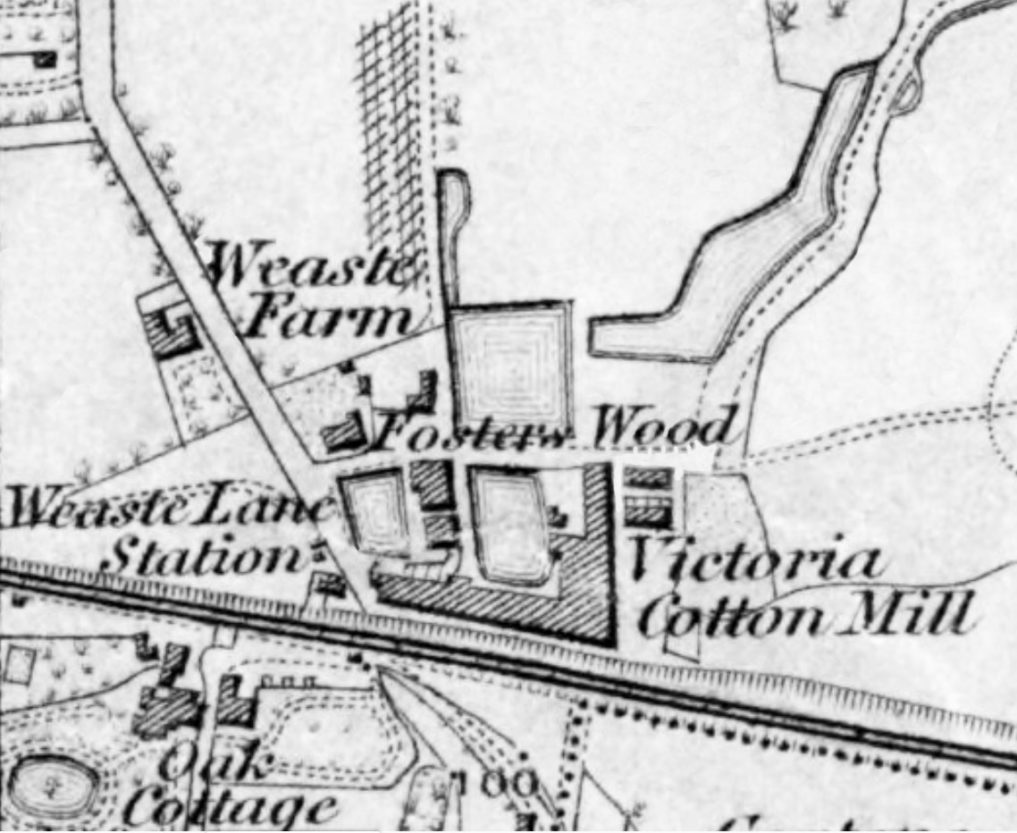
Samuel Brierley appears to have had extensive land holdings across Pendleton, for in 1777 the 33 acre Lightbown estate at Foster Wood in the Weaste area is for sale. Brierley has some local status as he is mentioned in the sale as a previous owner of this bleaching croft-cum-farm which is, ‘in a high state of cultivation…. is excellently well calculated for a manufacturer or calico printer with plenty of good water running through’ and ‘accommodation of pits and the necessary conveniences with them for washing goods’. John Booth, the tenant, was clearly experiencing ongoing financial difficulties as earlier in the year he disposed of all his live stock (including his pointer), farm carts, hay, stabling, gardening utensils and household furniture possibly with a view to raising capital to invest in the bleaching business which in the end appears to have been fruitless, leading to his bankruptcy. Nevertheless the sale notice reveals the mixed economy during this period, an 18th century ‘portfolio career’ involving farming and domestic manufacture. Only two years later an auction notice for the same Lightbounds estate, tenanted by Hugh Albiston, is advertised again, emphasising its suitability for calico printing and dyeing and its proximity to the turnpike to the south. Much later this area is associated with the Victoria Mill and the celebrated Friedrich Engels and his partner Godfrey Ermen who left money in his will for good causes.

In 1783, Thomas Butterworth Bayley placed a notice to let in the Mercury for 22 acres of land with a house and orchards at Irlams. The land facing south west and ideally located for a bowk house with plenty of water suitable for a cloth or yarn crofter is probably the land in the vicinity of the present Light Oaks park. This advertisement gives an indication of the northern extent of the Hope Hall estate during this period. The later 1845 ordnance survey map shows the concentration of stretches of water at this location the final remnant of which is the current park duckpond. Also in 1783 an advert is placed for a schoolmistress ‘recommended for industry, sobriety and good temper’ to teach spelling and reading English along with knitting and sewing. This is an early reference to the Broomhouse Lane school ‘….. for 70 to 80 scholars……which has a good schoolroom, a chamber over it with a garden rent free in a pleasant populous neighbourhood’. Further research is necessary to establish who the first schoolmistress was but it is tragic to note that this historic school existed until relatively recent times, the site now marked by a carpark.
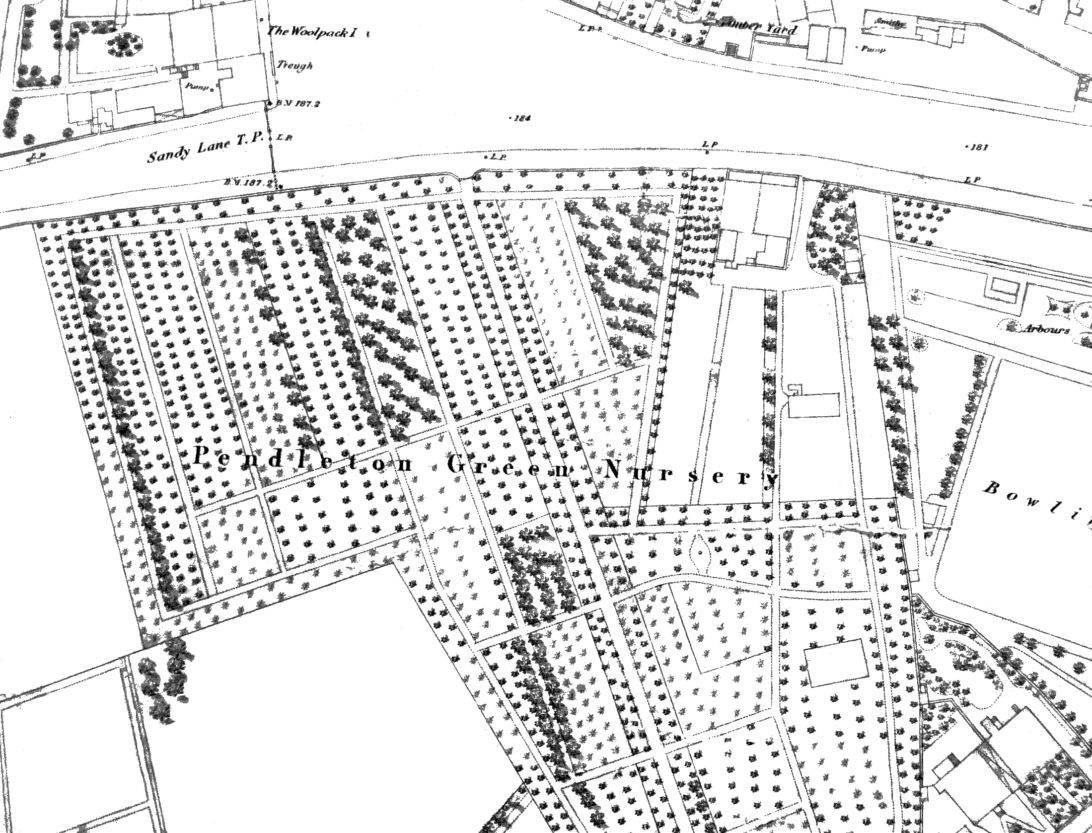
Giles Boardman is a local, colourful character in Pendleton who takes advantage of the growing demands for plants, establishing a commercial nursery in the early 1780s at Sandy Lane. His newspaper adverts list a wide variety of fruit, seeds, vegetable and trees for sale, some ‘imported from London’ but many are grown on his land at Chat Moss where he also has turbery rights. Boardman combines his nursery business at Sandy Lane with a ‘summer garden centre’ advertising walks, bowers and pleasure gardens no doubt attempting to emulate the popular pleasure gardens in the capital and other fashionable watering places. Once the ‘strawberry season’ has ended Boardman advertises teas, coffee and foreign wines to coax in the public. It is likely that the present-day Nursery Street commemorates Giles Boardman’s enterprise, one of several plant nurseries established along the future Eccles Old Road which took advantage of the sand and gravel along its length and nearby Chat Moss peat. The nursery is still operating in the 1790s when Giles’ son John advertises a performance by the band of the Royal Manchester Volunteers, accompanied with ice cream and cakes and a range of fresh fruit ‘in high perfection’ suitable for preserving. The Boardmans’ story does not have a good ending, however, when one Giles Boardman, nurseryman, is made bankrupt in 1801 and incarcerated in Lancaster gaol. In 1809 John Boardman appears to have abandoned the strawberry gardens in favour of selling beer from the Sandy Lane Tavern. Giles Boardman died in 1821 at the age of 73.
The extent of agriculture across the township cannot be underestimated at this period. Again the newspapers give us interesting evidence. When the Little Bolton farm is let in 1781 the advert lists the fruit trees on the land including cherry, plum, various pears and ‘upwards of one thousand apple trees of the best kind’. The narrative suggests the estate is suitable ‘for a person in the gardening way’, as does the 1783 sale by auction of Hart Hill ‘country house and gardens’, (located at the junction of the current Weaste Lane and Eccles Old Road), which marked the departure from Pendleton of Thomas Percival MD, a resident of national repute. Hot houses also appear in adverts when a house, a ‘neat villa’ is let complete with two gardens and a hot house with a vine ‘coming to a state of perfection’.
In 1783 Samuel Brierley advertised a ‘small, comfortable and warm house with pretty garden near to the chapel for rent’. The house, near to Brierley’s St Thomas chapel, overlooked the Irwell valley, soon to witness the early development of the factory system in the Pendleton township. This was to have ongoing impact on population growth and industrial activity. In 1777 the Mercury had announced the sale of the nearby Pendleton Old Hall estate, complete with the disused corn mill, a part of which was now being used as a bleaching croft. Bought by William Douglas in 1782, he set about establishing a water spinning enterprise, selling off the surplus corn milling equipment whilst advertising for wood and iron turners and filers. It was common for early spinning mills to be adapted from corn mills and also for manufacturers to build their own equipment. Douglas was taking advantage of the new developments in spinning technology, notably Richard Arkwright’s water frame. Douglas traded yarn from his warehouse in Manchester and like many early textile manufacturers he lived adjacent to his factory, in this case the Pendleton Old Hall. William Douglas has a poor reputation based on his use of parish apprentices – he was estimated to have around 150, mostly from London parishes. He employed two agents, John Plant and Philip French, to liaise with the various Poor law administrators in Essex and the London parishes, provide updates and answer complaints about apprentices working in Pendleton and Douglas’s other mill in Holywell. He was not alone locally in using parish apprentices: in 1791, 48 parish apprentices were sent from Alverstoke in Hampshire to work at the Bank Mill of Ackers and Beevor in Salford , ‘in an airy situation near Manchester.’ Douglas’s name lives on today at Douglas Green in Charlestown.
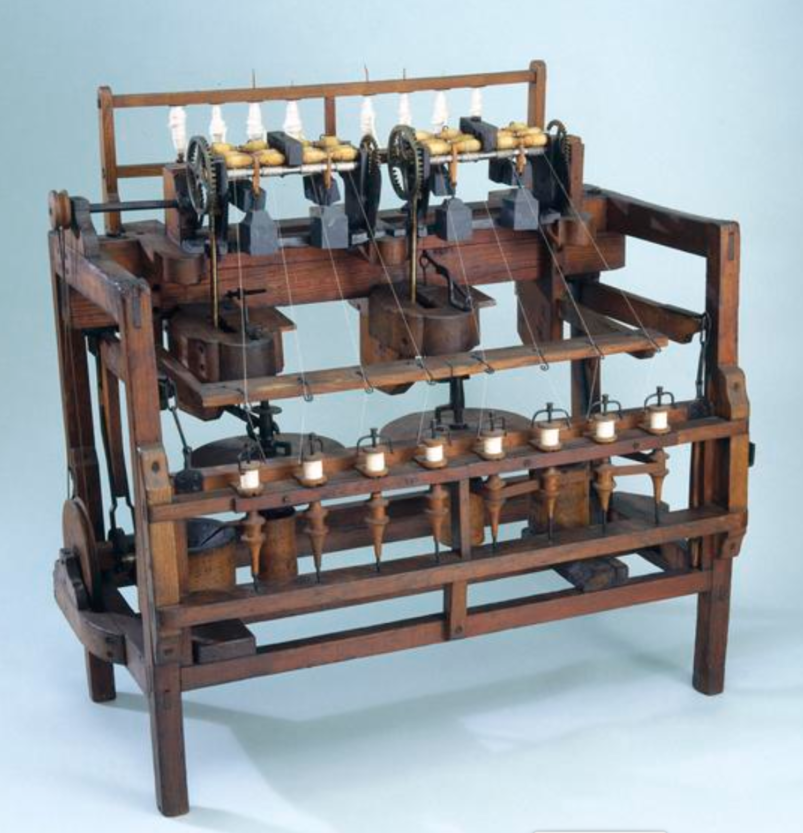

William Douglas took advantage of the Eighteenth century technological developments in spinning when he established a mill at Pendleton Old Hall. Arkwright’s 1776 specification for the water frame (right) and a later reconstruction can be seen above.
Several notices in the Mercury such as this of 1785 provides evidence of Douglas’s reputation which led to his local nickname Black Douglas:‘WHEREAS John Wrigley, late of Wirksworth, in the County of Derby, and Edward Hughes, late of Holywell, in the County of Flint, John Anderson, commonly called Cragg. late of New Mills, near Glasgow, in Scotland and Jomes Barrett, Margaret Willson, George Willson and William Willson, from the North of Loncashire, and Hannah Potter and Mary Walker, late of Cromford, in the County of Derby, Nine Servants, under Articles with Messrs. William Douglas and Co. Pendleton, near Manchester, Cotton Manufacturers, having left their respective Services, against the Consent of their Masters, the term of Contract not being expired, to the great loss and disappointment of their said Masters, NOTICE is hereby Given, That actions will brought by the said William Douglas and Co. against Persons who shall give Employment to the said John Wrigley, Edward Hughes, John Anderson or Cragg, James Barrett, Margaret Willson, George Willson, and William Willson, Hannah Potter, Mary Walker, or any them; John Wrigiey is about 18 years of age, 5 Feet high, much pitted with the Small Pox, and Bow-leg’d, and Scar on his Face ; Edward Hughes is about 19 Year-of age about 5 Feet 6 Inches high, slender made, and a dark Complexion; John Anderson or Cragg is about 17 years of Age, 5 Feet high, stout made, with a dark Complexion, speaks a little Scotch; James Barrett about 14 or 1 3 Years Age, about 4 Feet 10 Inches high; Margaret Willson, George Willson, and William Willson, is gone along with their Mother Elizabeth Willson Hannah Potter is about 20 Years of Age, about 5 Feet 4 Inches high, dark complexion, and thick Neck; Mary Potter is about 20 Years of Age, about 5 Feet 6 Inches high, stout made, and of light Complexion. N B. Most of the above are supposed to be at the Hodder Cotton Factory, belonging to Mr. Michael Emmit, near Clitheroe.’
Many similar notices appeared in the newspapers, often accompanied by descriptions of the absconder’s clothing. More often than not, the males wore a coat, breeches and waistcoat, accompanied with neckerchief and shoes ‘with ties’ replicating the clothing of their superiors but in less exclusive fabrics such as fustian, corduroy, velvet and cotton. Recent research has shown that shoemaking was far more extensive than previously thought, supporting the view that shoes were worn by all levels of society in preference to clogs. A range of other sources from the period also indicate that fashionable dress was not confined to the privileged ranks but extended to the working multitude – labourers, small farmers and tradespeople who formed the bulk of the population.
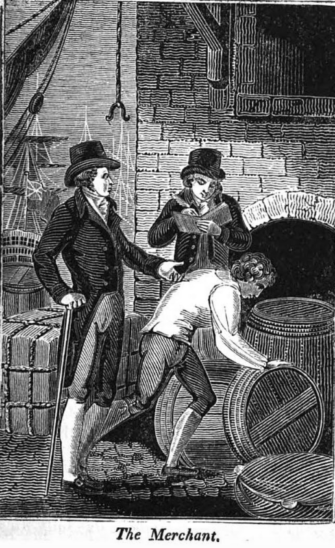
The importance of the second-hand clothing trade cannot be underestimated in spreading fashion in the growing urban areas. And as demonstrated in thefts from bleaching fields there was clear evidence of the ready market for stolen cloth and yarn. Cotton’s greatest asset was its washability, leading to improved hygiene and health and once worn-out was recycled into children’s clothing, quilts and cleaning cloths. Pendleton, with its various social levels including local gentry, manufacturers, crofters, domestic servants, farmers and growing professional class, many of whom had places of business in nearby Manchester, would have been equally subject to the changing character of dress during the second half of the 18th century.
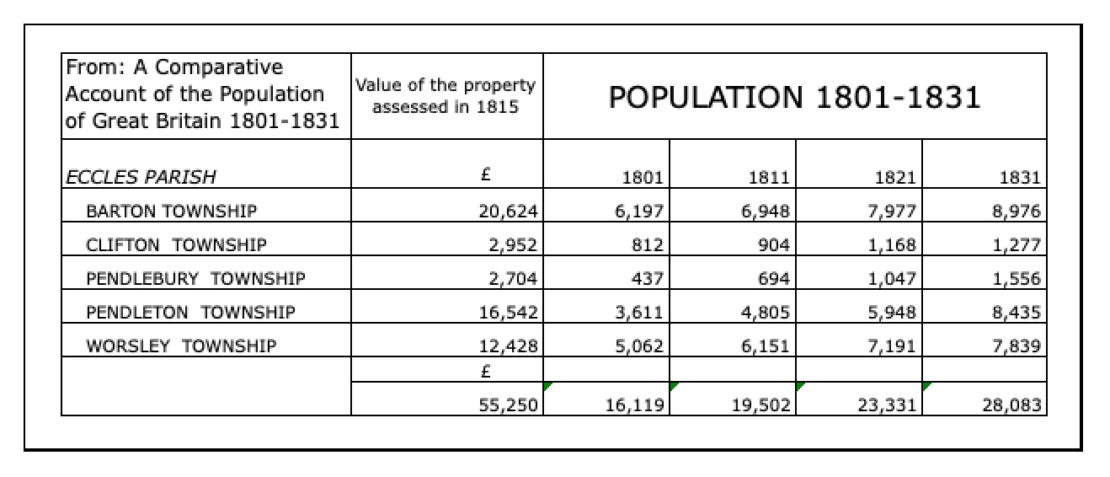
The two sets of data below and that above gives an indication of the population increases in the Pendleton Township from 1801 to 1831. The census of 1831 (below) gives more detail regarding population trends, occupations and schooling across the Township. The information is taken from a Report of a Committee of the Manchester Statistical Society, on the State of Education in the Township of Pendleton, 1838 (Source: Journal of the Statistical Society of London, Mar., 1839, Vol. 2, No. 2 (Mar.,1839), pp. 65-83)
